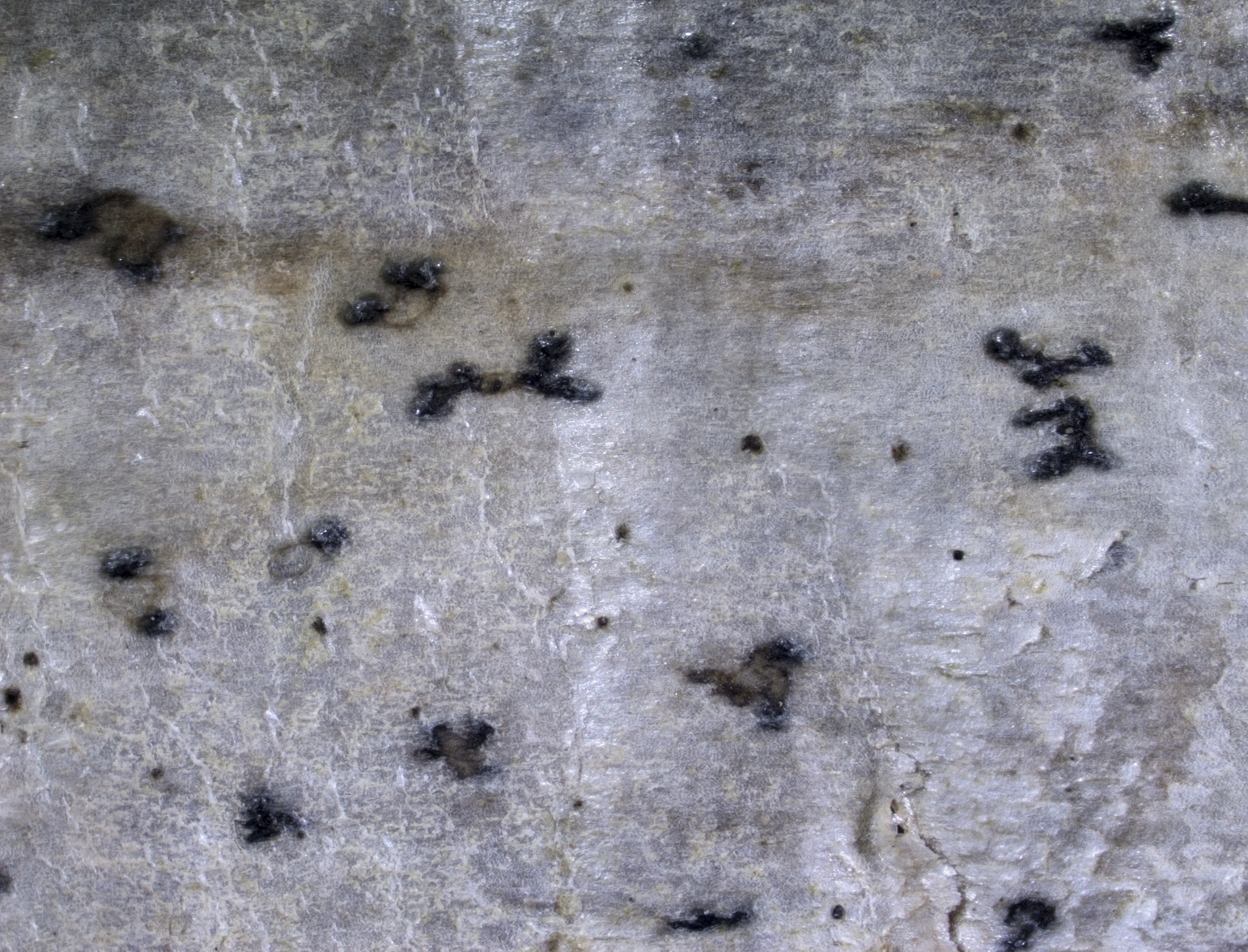Arthothelium orbilliferum
Arthothelium orbilliferum collected from a young oak in a boreo-nemoral rainforest at Storavatnet SØ in Stord (O-L-222466).
Arthothelium orbilliferum growths on smooth bark of deciduous trees in boreo-nemoral rainforests south of Bergen. It is characterized by small brownish black, maculate apothecia on a thin, pale thallus lacking photobionts. The colorless spores are divided by 5–6 transverse and 2–3 longitudinal septa. The apical cell is not enlarged.
- Innhold
- Description
- Ecology
- Distribution in Norway and the Nordic countries
- Global distribution
- Similar species
Description
Thallus
The thin and indistinct thallus discolors the host bark white to pale cream. The margin is not determinate or more often bordered by a distinct brown line. Photobionts are absent.
Fruitbodies
The apothecia are either level with the thallus or indistinctly raised, and rounded, angular, shortly elongate, bluntly lobate or star-shaped. They are brownish black, without pruina, and often disintegrate in the centre. They are 0.3–0.7 mm in size and 50–70 μm tall. The disc is flat to slightly convex.
The epithecium is 8–15 μm tall, olive-brown in color, and contains granules.
The hymenium is colorless and 30–50 μm tall.
The hypothecium is unpigmented and up to 10 μm tall.
The paraphysoids are 1–1.5 μm wide. Their tips are slightly widened to 2–3 µm.
The asci are subglobose, with stipe, 34–62 × 26–43 µm, 8-spored.
The spores are colorless, obovoid, 16–30 × 7–13 μm in size, and divided by 5–6 transverse and 2–3 longitudinal septa. An enlarged and undivided apical cell is not developed.
Anamorph
Pycnidia are brownish black, either immersed in the thallus or slightly raised, and 50–100 µm in size. The wall is olive-brown. The rod-shaped conidia are 3–5 × 0.5–1.0 μm large.
Chemistry
The thallus does not react with C, K, KC, Pd, or UV (C–, K–, KC–, Pd–, UV–). Lichen secondary compounds have not been detected by TLC.
The hymenium reacts I+ blue turning red and KI+ deep blue. A KI+ blue ring structure has been observed in the asci.
The brown pigment in the epithecium and in the wall of the pycnidia changes to greenish in K solution.
Arthothelium orbillliferum collected from an old leaning Sorbus aucuparia in a boreo-nemoral rainforest at Storavatnet SØ in Stord (O-L-206466).
Ecology
Arthothelium orbilliferum is confined in Norway to the boreo-nemoral rainforests in Vestland south of Bergen. It often occurs together with A. lirellans in rather open, pine dominated forests with a high proportion of deciduous trees including common hazel (Corylus avellana), holly (Ilex aquifolium), oak (Quercus spp.), and rowan (Sorbus aucuparia). Arthothelium orbilliferum often occurs on thin branches with sparse lichen cover and may be a weak pioneer species.
It is a highly oceanic, warm-temperate species that is further reported from old woodlands in the British Islands and France.
Distribution in Norway and the Nordic countries
The known distribution of Arthothelium orbilliferum in the Nordic countries is limited to the core area of the boreo-nemoral rainforests south of Bergen in Norway.
Global distribution
Outside the Nordic Countries, Arthothelium orbiliferum is known from western Europe including the British Islands (W Britain, Ireland, Scotland) and France.
Arthothelium orbiliferum collected from oak in a boreo-nemoral rainforest at Nesskogen in Stord (O-L-223788).
Similar species
Arthothelium orbilliferum may be confused with Arthothelium lirellans by external appearance, and the two species grow in similar habitats. Arthothelium orbilliferum can be distinguished from that species by the paler thallus and less elongated apothecia with a greater tendency to disintegrate in the centre. The spores are slightly wider relative to their length, not slightly curved, and have a higher number of longitudinal septa. The hymenium is I+ blue turning red instead of persistently blue.
Literature
Cannon P, Ertz D, Frisch A, Aptroot A, Chambers S, Coppins BJ, Sanderson N, Simkin J and Wolseley P (2020). Arthoniales: Arthoniaceae. Revisions of British and Irish Lichens 1: 1–48.
Ihlen PG and Coppins BJ (1999). Two species of Arthothelium (Arthoniaceae, Arthoniales) new to Scandinavia. Nova Hedwigia 69(3–4): 391–397.
Sundin R (1999). Phylogenetic and taxonomic studies within Arthonia Ach. (Ascomycetes, Arthoniales). Doctoral dissertation, Department of Bot., Stockholm University.



